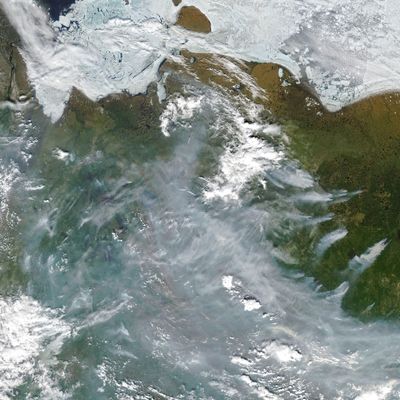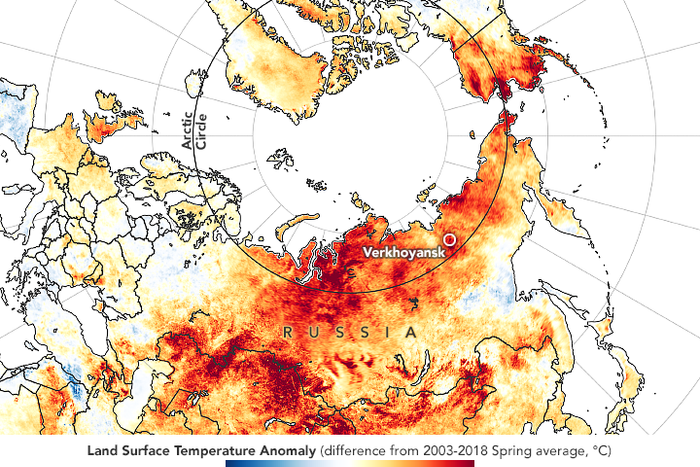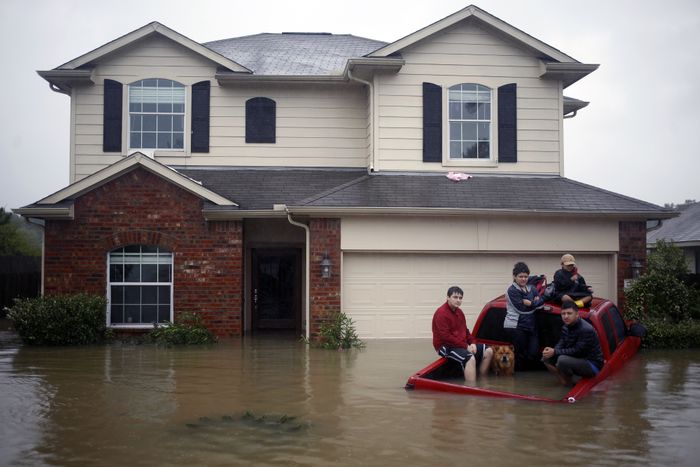
On June 20, in the small Siberian town of Verkhoyansk, north of the Arctic Circle, a heat wave baking the region peaked at 38 degrees Celsius — just over 100 degrees Fahrenheit. It was the highest temperature ever recorded in the Arctic. In a world without climate change, this anomaly, one Danish meteorologist calculated, would be a 1-in-100,000-year event. Thanks to climate change, that year is now.
If you saw this news, last weekend, it was probably only a glimpse (primetime network news didn’t even cover it). But the overwhelming coverage of perhaps more immediately pressing events — global protests, global pandemic, economic calamity — is only one reason for that climate occlusion. The extreme weather of the last few summers has already inured us to temperature anomalies like these, though we are only just at the beginning of the livable planet’s transformation by climate change — a transformation whose end is not yet visible, if it will ever be, and in which departures from the historical record will grow only more dramatic and more disorienting and more lethal, almost by the year. At just 1.1 degrees Celsius of warming, where the planet is today, we have already evicted ourselves from the “human climate niche,” and brought ourselves outside the range of global temperatures that enclose the entire history of human civilization. That history is roughly 10,000 years long, which means that in a stable climate you would only expect to encounter an anomaly like this one if you ran the full lifespan of all recorded human history ten times over — and even then would only encounter it once.
You may register temperature records like these merely as the sign of a new normal, in which record-breaking heat waves fade out of newsworthiness and into routine. But the fact of those records doesn’t mean only that change has arrived, because the records are not being set only once; in many cases, they are being set annually. The city of Houston, for instance, has been hit by five “500-year storms” in the last five years, and while the term has obviously lost some of its descriptive precision in a time of climate change, it’s worth remembering what it was originally meant to convey: a storm that had a one-in-500 chance of arriving in any given year, and could therefore be expected once in five centuries. How long is that timespan, the natural historical context for a storm like that? Five hundred years ago, Europeans had not yet arrived on American shores, so we are talking about a storm that we would expect to hit just once in that entire history — the history of European settlement and genocide, of the war for independence and the building of a slave empire, of the end of that empire through civil war, of industrialization and Jim Crow and World War I and World War II, the cold war and the age of American empire, civil rights and women’s rights and gay rights, the end of the cold war and the “end of history,” September 11 and 2008. One storm of this scale in all that time, is what meteorological history tells us to expect. Houston has been hit by five of them in the last five years, and may yet be hit with another this summer — which is already predicted to be a hurricane season of unusual intensity. Of course, that won’t be the end of the transformations. Climate change will continue, and those records — high temperatures, historic rainfall, drought, and wind speed and all the rest — will continue to fall. From here, literally everything that follows, climate-wise, will be literally unprecedented.
The arctic numbers from June 20 are terrifying enough; with more context they become only more so. It was warmer there than it was that same day, in Miami, Florida. In fact, it was warmer north of the Arctic Circle than it has ever been, on any June day, in the entire recorded history of Miami, which has only once, in the whole tropical century for which temperatures there have been registered, reached 100. It was about 30 degrees Fahrenheit warmer, in Verkhonaysk, than the average high temperature in the region for June, which means the arctic record was the equivalent, in terms of temperature anomaly, of a 110-degree June day in New York or a 115-degree June day in Washington, D.C. According to preliminary satellite data, land surface temperature in parts of arctic Siberia reached that level last week, too — 45 Celsius, or 113 Fahrenheit. In terms of temperature anomaly, that’s the equivalent of a 130-degree day in D.C. On Capitol Hill, that would be, very comfortably, lethal heat.
Thankfully, for Americans at least, that isn’t how global warming works — its punishing effects are distributed unequally around the globe, and, at the moment, the Arctic is being punished most vindictively, warming at three times the rate of the rest of the planet. In Siberia, in May, temperatures averaged as much as 10 degrees Celsius higher than normal. The arrival of the arctic summer reignited “zombie fires” that had, improbably, burned through the arctic winter, smoldering in peat rather than burning out. Those fires, like all fires, released carbon, which is stored in trees as surely as it is in coal, in this case releasing as much CO2 in the last 18 months as had been produced by Siberian wildfires in the last 16 years. In early June, an industrial-scale oil-storage facility there collapsed when the melting permafrost on which it had been built finally destabilized, releasing about 21,000 tons of oil and turning local rivers red. That spill was about two-thirds the scale of the Exxon Valdez spill, which horrified an entire generation; this one, we’ve hardly read about, though it befell a far more ecologically degraded planet, with more than half of all carbon emissions ever produced by the burning of fossil fuels in the entire history of humanity coming since the Valdez spill. Perhaps though is a less precise word than because, the intervening generation of environmental calamity having quite thoroughly normalized horrors like these. Even Vladimir Putin — presiding over a petrostate which, so far north, actually stands to benefit from some amount of global warming — declared it an emergency. All told, the planet’s melting permafrost contains twice as much carbon as hangs in the planet’s atmosphere today, and it’s expected that over the course of the century, at least 100 billion tons of it will be released through melt, about three years worth of global emissions and functionally enough to close the window on the goals of the Paris accords.
That window was not open very far to begin with. One recent study suggested that even the decarbonization targets of Britain and Sweden, often hailed as global climate leaders, would produce emissions between two and three times the carbon budget required to meet the Paris goals. (And those are just their decarbonization plans, which are probably optimistic.) Another analysis suggested that, for all the talk of halving our emissions by 2030 — as the IPCC says is necessary to safely avoid 2 degrees of warming — the planet has only a 0.3 percent chance of doing so. If Donald Trump won reelection, the analysis suggested, those chances would fall to 0.1 percent — one in a thousand.
If 2 degrees is now inevitable, that doesn’t make it comfortable. Indeed, it will be, for much of the world, a horror — and the space between those two things, inevitability and horror, is the one in which we will all be forced to learn to live. At 2 degrees, it’s expected that more than 150 million additional people would die from the effects of pollution, storms that used to arrive once every century would hit every single year, and that lands that are today home to 1.5 billion people would become literally uninhabitable, at least by the standards of human history.
Those projections will invariably prove imprecise, or perhaps worse — that is both the nature of science, which proceeds by revision, and humanity, which will likely adapt to at least some measure of these impacts. But the Siberian heat wave reminds us just how large the scale of necessary adaptation will likely be — requiring us to respond not just by shoring up the proverbial shorelines of our civilizations but by preparing them in much more fundamental ways to endure conditions never seen before in the whole span of human history. It is also a reminder of just how much we miss when we regard the projections of any neat, linear model of future warming as a straightforward prediction of that future and of what level of adaptation will be require — especially when we reflexively discount the uncertainty warnings scientists invariably include, as any lay reader (including me) is likely to do. Perhaps the most important lesson of the freakish Siberian heatwave is: however terrifying you find projections of future warming, the actual experience of living on a heated planet will be considerably more unpredictable, and disorienting.
Just how freakish and unpredicted is this heatwave? Over the last few years, a growing chorus of critics have argued against one climate model built on predictions of high-end carbon emissions in particular, called RCP8.5 —arguing that, though it had been endorsed by the U.N.’s IPCC and formed the basis of much recent science since that organization’s last major report, its projections were simply implausible, relying as they did on the dramatic growth of coal use over the course if the century. As I’ve written before, that pathway does indeed look increasingly hard to credit as a model of our future, and is best understood, in terms of emissions, as an absolute worst-case scenario, which would require almost a global climate nihilism to achieve. But for those suggesting we should discard that model, or any other that charted a high-end course for warming, the arctic heatwave makes a very strong counterargument. Because even in that worst-case pathway, hundred-degree summer days in the Arctic do not become routine until the very end of the century. This heat wave is, today, an outlier, not a routine event. But that doesn’t make it irrelevant. Instead, it is giving us at least a brief preview of what the world would look like, more than a half-century from now, in a timeline we understand to be, at least in terms of emissions, impossibly pessimistic. But if our timeline could accommodate such extreme events from that worst-case one, and decades ahead of schedule, it is also a sign that “timeline” is probably a misguided way of thinking about the new swirling universe of extreme events we are plunging headlong into. Making sense of climate change requires more than trying to determine where on a particular linear plot we are and where on it we are likely to be in ten years, or in fifty. It may require more profoundly revising our sense of linearity itself. In this way, global warming isn’t just scrambling our sense of geography, with Verkhonaysk, at least briefly, playing the role of Miami. It is also scrambling our sense of time. You may feel, because of the pandemic, that you are living to some degree in 1918. The arctic temperatures of the past week suggest that at least part of the world is living, simultaneously, in 2098.
But climate change isn’t just a brutal form of time travel, it is discombobulating to our very sense of time. When looking at projections for future warming, an event like the Siberian heat wave appears as an acceleration of history, but when looking at the paleoclimate record, it seems like a trip deep into the prehuman past, toward eras like those, lasting millions of years, when palm trees dotted the Arctic and crocodiles walked in their shade there. Especially at extreme levels, warming threatens the apparent march of progress on which the modern, Western “timeline” model of history was built. But at least until the arrival of large-scale carbon removal technologies, it also illustrates the fact that time — in the form of carbon emissions, which hang in the atmosphere for centuries — is irreversible. Because we are doing so much damage so quickly, destabilizing the entire planet’s climate in the space of a few decades, warming can seem like a phenomena of the present. But its effects will unfurl for millennia, with the climate stabilizing perhaps only millions of years from now. Climate change unwinds history, melting ice frozen for many millennia and pushing rainforests like the Amazon closer to their long-overgrown savannah states. It also makes new history, drawing new borders and new riverbeds, turning breadbaskets like the Mediterranean into deserts and opening up arctic shipping routes to be contested by a new generation of great power military rivalries. It compresses history — those Houston storms, for instance, represent more than a millennia of extreme weather, concentrated in a period of just five years. And it scrambles and scatters it, too, disrupting the cycle of seasons and relocating rain belts and monsoons, among many other distortions. At the same time temperatures in Verkhoyansk reached 100 degrees, in other parts of Siberia it was snowing. Was it winter or summer, a Russian catching the national weather forecast could have been forgiven for asking. They may have wondered, is this our hellish climate future or the return of the Little Ice Age?
Contemplating the impacts of climate change from this perspective can seem naïvely abstract — and it is, when compared to the storms and the wildfires and the droughts. (Not to mention the literal plague of locusts, 360 billion of them, which have devastated agriculture in East Africa and South Asia this year, descending in clouds so thick you couldn’t see through the insects and leaving millions hungry.) But in addition to its humanitarian cruelties, for instance making pandemics like COVID-19 much more likely, warming is already recalibrating much more hard-headed models of time, too. This is a sign that warming is truly the meta-narrative of our century, touching every aspect of our lives. Beyond the catastrophes and crises, the surreal and disorienting aspects of climate change are showing up even in the most numbingly pragmatic places. Like, for instance, mortgages.
“Up and down the coastline, rising seas and climate change are transforming a fixture of American homeownership that dates back generations: the classic 30-year mortgage,” Christopher Flavelle of the New York Times reported June 19. (As it happens, the day before the record-setting temperatures in the Arctic.) As Kate Mackenzie has relentlessly chronicled for Bloomberg, mortgages aren’t the first or only financial instrument to feel the intrusion of a new climate reality much less forgiving, and less stable, than the one on which not just the financialization of the global economy but indeed all of human civilization has been erected. Insurance and reinsurance, municipal bonds and sovereign wealth funds, boutique hedge funds and massive asset-management operations are all beginning to reckon with a future made, at least, much rockier by climate change. How much rockier? Well, according to a Climate Central estimate, at least half a million American homes are on land expected, 30 years from now, to flood every single year. Altogether, those homes are today worth $241 billion. This is just homes, just in America, and annual flooding isn’t the only flood risk a homeowner or a bank might want to consider, which means, even looking only at flooding, many, many more homes are vulnerable than that. Of course, flooding is not, by any stretch, the only climate risk those homes and homeowners would face.
Like many of those other financial instruments, a mortgage isn’t just an instrument but also a theory of time — a bet on future value built on the proposition that three decades is a long enough period to absorb the short-term turbulence of real-estate markets and a short-enough period that larger systemic shocks would not have time to develop and reverberate. That is, at least, how the mortgage looks from the bank side. From the consumer side, a mortgage represents a related, but slightly different, theory of time. For most of postwar American history, it has represented “adulthood,” as defined in mostly white and middle-class-and-up terms. For all those distortions and delusions embedded in it — ideas about housing and the real-estate market but also race and class and urbanization and family structure — the 30-year mortgage also embedded an idea about the stability of society through time, that one could expect to arrive at the end of adulthood in a world recognizable to the person who began it, and indeed that whatever changes had transpired would be, on net, of value to the homeowner, who by virtue of his or her property had become a small-scale stakeholder in the prospects of the community, the region, the nation and indeed the world as a whole. As the Times reports, both sides of that bargain are already, now, beginning to look very different.
Home buyers are increasingly using mortgages that make it easier for them to stop making their monthly payments and walk away from the loan if the home floods or becomes unsellable or unlivable. More banks are getting buyers in coastal areas to make bigger down payments — often as much as 40 percent of the purchase price, up from the traditional 20 percent — a sign that lenders have awakened to climate dangers and want to put less of their own money at risk.
And in one of the clearest signs that banks are worried about global warming, they are increasingly getting these mortgages off their own books by selling them to government-backed buyers like Fannie Mae, where taxpayers would be on the hook financially if any of the loans fail.
One academic quoted in the story, Jesse Keenan of Tulane, painted the picture even more starkly: “Conventional mortgages have survived many financial crises,” he said, “but they may not survive the climate crisis.”
As a divining rod of the future, the mortgage market is a crude tool, focused only on a narrow set of values, when we know warming will affect many more, registering only a small set of changes, and registering them only according to a purposefully blinkered set of metrics: what the value of a property is, how it is likely to change, and what amount of risk is involved in making a bet on its worth and the reliability of mortgage-holders to pay. Already, the terms are shifting to reflect new realities — a doubling of the required down payment reflecting a much higher sense of risk. But, as Mackenzie writes, more precise financial tools won’t necessarily protect us from climate risks — only allow those utilizing them to profit from them, perhaps even in discriminatory ways. Presumably, in the years ahead, banks will continue to modify their calculations, so that the mortgage will survive, at least in some modified form, reflective of some additional climate risk — perhaps, depending on the place, quite a lot more risk. But surviving in what form, exactly, and making what claim about the stability of the near future and how comfortably we may all live in it? Time will tell.
































